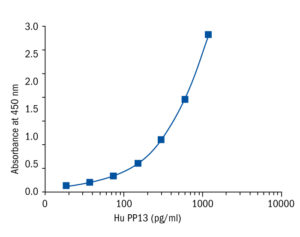Placental Protein 13 Human ELISA
Placental protein 13 (PP13, Galectin 13) is the member of the beta-galactoside binding S-type galectin superfamily, whose members are important in placenta implantation and remodelling of maternal arteries. PP13 binds to beta-galactoside residues of several proteins on the cell surface, cytoskeleton and extracellular matrix, thereby generating various responses such as immune responses and influencing other functions like apoptosis and molecular recognition. PP13, which is predominantly produced by placental tissue, possesses a conserved carbohydrate binding domain, to which two proteins Annexin-II and Actin-beta bind. These proteins are considered to play a key role in placentation and maternal artery remodelling respectively. Human PP13 is a relatively small protein with 139 amino acids and is composed of two identical 16 kDa subunits held together by disulfide bonds. PP13 was first isolated from placenta and especially from the syncytiotrophoblast in 1983 by Bohn et. al. It is localized to the syncytiotrophoblast brush border membrane, and detected in maternal and cord blood. Though it is found primarily in placenta, some PP13 expression was also detected in healthy spleen, kidney and bladder tissue and in liver adenocarcinoma, neurogen tumour and malignant melanoma. The serum levels of PP13 slowly increase during a normal pregnancy but abnormally low levels of PP-13 were detected in first trimester serum samples of women subsequently developing fetal growth restriction and preeclampsia, especially in cases with early onset. Elevated serum concentrations of PP-13 have been found in the second and third trimester in women with preeclampsia, intrauterine growth restriction (IUGR) and in preterm delivery. Another study concluded that first-trimester serum levels of PP13 may serve as a suitable marker for preterm preeclampsia but are weak for the prediction of severe preeclampsia and ineffective for mild preeclampsia at term.
Features
- It is intended for research use only
- The total assay time is less than 3.5 hours
- The kit measures PP13 in serum, cord blood serum and placental tissue extract
- Assay format is 96 wells
- Standard is recombinant protein based
- Components of the kit are provided ready to use, concentrated or lyophilized
Research topic
Reproduction
Type
Sandwich ELISA, Biotin-labelled antibody
Applications
Serum, Cord Blood
Sample Requirements
serum and cord blood: 50 ml of sample/well placental tissue extract samples: dilution 250×/well
Storage/Expiration
Store the complete kit at 2–8°C. Under these conditions, the kit is stable until the expiration date (see label on the box).
Calibration Curve

Calibration Range
18.75–1200 pg/ml
Limit of Detection
7.6 pg/ml
Intra-assay (Within-Run)
n = 8; CV = 3.1%
Inter-assay (Run-to-Run)
n = 6; CV = 7.7%
Spiking Recovery
93,50%
Dilutation Linearity
109,90%
– Farina A, Eklund E, Bernabini D, Paladino M, Righetti F, Monti G, Lambert-Messerlian G. A First-Trimester Biomarker Panel for Predicting the Development of Gestational Diabetes. Reprod Sci. 2016 Nov 11;
– Farina A, Bernabini D, Zucchini C, De Sanctis P, Quezada MS, Mattioli M, Rizzo N. Elevated maternal placental protein 13 serum levels at term of pregnancy in postpartum major hemorrhage (>1000 mLs). A prospective cohort study. Am J Reprod Immunol. 2017 May 15. doi: 10.1111/aji.12702

